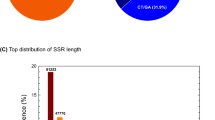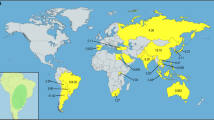Abstract
Hybridization is regarded as a rapid mechanism for increasing genetic variation that can potentially enhance invasiveness. Tamarix hybrids appear to be the dominant genotypes in their invasions. Exotic Tamarix are declared invasive in South Africa and the exotic T. chinensis and T. ramosissima are known to hybridize between themselves, and with the indigenous T. usneoides. However, until now, it was not known which species or hybrid is the most prevalent in the invasion. With a biocontrol programme being considered as a way of suppressing the alien Tamarix populations, it is important to document the population genetic dynamics of all species in the region. This investigation sought to identify Tamarix species in southern Africa and their hybrids, describe their population structure, and reveal the geographic origin of the invasive species. To achieve this, nuclear Internal Transcribed Spacer (ITS) sequence data and the multilocus Amplified Fragment Length Polymorphisms (AFLPs) markers were used. Phylogenetic analysis and population genetic structure confirmed the presence of three species in South Africa (T. chinensis, T. ramosissima and T. usneoides) with their hybrids. The indigenous T. usneoides is clearly genetically distant from the alien species T. chinensis and T. ramosissima. Interestingly, the Tamarix infestation in South Africa is dominated (64.7 %) by hybrids between T. chinensis and T. ramosissima. The exotic species match their counterparts from their places of origin in Eurasia, as well as those forming part of the invasion in the US.






Similar content being viewed by others
References
Abbott RJ (1992) Plant invasions, interspecific hybridization and the evolution of new plant taxa. Trends Ecol Evol 7:401–405. doi:10.1016/0169-5347(92)90020-C
Abbott RJ, Brennan AC, James JK, Forbes DG, Hegarty MJ, Hiscock SJ (2009) Recent hybrid origin and invasion of the British Isles by a self-incompatible species, Oxford ragwort (Senecio squalidus L., Asteraceae). Biol Invasions 11:1145–1158. doi:10.1007/s10530-008-9382-3
Ainouche ML, Fortune PM, Salmon A, Parisod C, Grandbastien MA, Fukunaga K, Ricou M, Misset MT (2009) Hybridization, polyploidy and invasion: lessons from Spartina (Poaceae). Biol Invasions 11:1159–1173. doi:10.1007/s10530-008-9383-2
Anderson EC (1949) Introgressive hybridization. Wiley, New York
Bailey C, Carr T, Harris S, Hughes C (2003) Characterization of angiosperm nrDNA polymorphism, paralogy, and pseudogenes. Mol Phylogenet Evol 29:435–455. doi:10.1016/j.ympev.2003.08.021
Baum B (1978) The genus Tamarix. The Israel Academy of Science and Humanities, Jerusalem
Blair AC, Hufbauer AR (2009) Geographic patterns of interspecific hybridization between spotted Knapweed (Centaurea stoebe) and diffuse Knapweed (C. diffusa). Invasive Plant Sci Manag 2:55–69. doi:10.1614/IPSM-08-105.1
Bonin A, Erich D, Manel S (2007) Statistical analysis of amplified fragment length polymorphism data: a toolbox for molecular ecologists and evolutionists. Mol Ecol 16:3737–3758. doi:10.1111/j.1365-294X.2007.03435.x
Bredenkamp CL (2003) Tamaricaceae. In: Germishuizen G, Meyer NL (eds) Plants of southern Africa. National Botanical Institute, Pretoria, p 927
Bredenkamp CL, Phepho N (2008) Hybridization of Tamarix usneoides and Tamarix ramosissima. South African Botanical Institute, Pretoria
Cuda JP, Christ LR, Manrique V, Overholt WA, DA Wheeler Williams (2012) Role of molecular genetics in identifying ‘fine-tuned’ natural enemies of the invasive Brazilian peppertree, Schinus terebinthifolius: a review. Biol Control 57:227–233. doi:10.1007/s10526-011-9418-y
Darriba D, Taboada GL, Doallo R, Posada D (2012) jModelTest 2: more models, new heuristics and parallel computing. Nat Methods 9(8):772
DeLoach CJ, Knutson AE, Moran PJ, Everitt JH, Michels GJ, Muegge MA, Randal CW, Fain TG, Donet MP, Ritzi CM (2009) Progress on biological control of saltcedar in the Western U.S.: Emphasis—Texas 2004–2009. AgriLife Research. http://www.orangentia.net/SaltcedarPublicReportHandout11-10-09.pdf. Accessed on 23 June 2015
Dice L (1945) Measures of the amount of ecologic association between species. Ecology 26:297–302. doi:10.2307/1932409
DiTomaso JM (1998) Impact, biology and ecology of saltcedar (Tamarix spp) in the south-western United States. Weed Technol 12:326–336
Dudley TL, Bean DW, Pattison RR, Caires A (2012) Selectivity of decision making framework for restoring riparian zones degraded by invasive alien plants in South Africa a biological control agent, Diorhabda carinulata Desrochers, 1870 (Coleoptera: Chrysomelidae) for host species within the genus Tamarix Linneaus, 1753. Pan-Pac Entomol 88:319–341. doi:10.3956/2011-10.1
Ellstrand NC, Schierenbeck KA (2000) Hybridization as a stimulus for the evolution of invasiveness in plants? Proc Natl Acad Sci USA 97:7043–7050. doi:10.1073/pnas.97.13.7043
Evanno G, Regnaut S, Goudet J (2005) Detecting the number of clusters of individuals using the software STRUCTURE: a simulation study. Mol Ecol 14:2611–2620. doi:10.1111/j.1365-294X.2005.02553.x
Falush D, Stephens M, Pritchard JK (2007) Inference of population structure using multilocus genotype data: dominant markers and null alleles. Mol Ecol Notes 7:574–578. doi:10.1111/j.1471-8286.2007.01758.x
Felsenstein J (1985) Confidence limits on phylogenies: an approach using the bootstrap. Evolution 39:783–791. doi:10.2307/2408678
Floate KD, Whitham TG (1993) The “hybrid bridge” hypothesis: host shifting via plant hybrid swarms. Am Nat 141:651–662. http://www.jstor.org/stable/2462756
Fritz RS, Nichols-Orians CM, Brunsfeld SJ (1994) Interspecific hybridization of plants and resistance to herbivores: hypotheses, genetics, and variable responses in a diverse herbivore community. Oecologia 97:106–117. doi:10.1007/BF00317914
Gaskin JF, Kazmer DJ (2009) Introgression between invasive saltcedars (Tamarix chinensis and Tamarix ramosissima) in the USA. Biol Invasions 11:1121–1130. doi:10.1007/s10530-008-9384-1
Gaskin JF, Schaal BA (2002) Hybrid Tamarix widespread in U.S. invasion and undetected in native Asian range. Proc Natl Acad Sci USA 99:11256–11259. doi:10.1073/pnas.132403299
Gaskin JF, Schaal BA (2003) Molecular phylogenetic investigation of U.S. invasive Tamarix. Syst Bot 28:86–95. doi:10.1043/0363-6445-28.1.86
Gaskin JF, Birken AS, Cooper DJ (2011a) Levels of novel hybridization in the saltcedar invasion compared over seven decades. Biol Invasions 1:1–7. doi:10.1007/s10530-011-0110-z
Gaskin JF, Bon M, Cock MJW, Cristofaro M, De Baisé A, De Clerck-Floate R, Ellison CA, Hinz HL, Hufbauer RA, Julien MH, Sforza R (2011b) Applying molecular based approaches to classical biological control of weeds. Biol Control 58:1–21. doi:10.1016/j.biocontrol.2011.03.015
Gaskin JF, Schwarzländer M, Grevstad FS, Haverhals MA, Bourchier RS, Miller TW (2014) Extreme differences in population structure and genetic diversity for three invasive congeners: knotweeds in western North America. Biol Invasions 16:2127–2136. doi:10.1007/s10530-014-0652-y
Goolsby JA, De Barro PJ, Makinson JR et al (2006) Matching the origin of an invasive weed for selection of a herbivore haplotype for biological control programme. Mol Ecol 15:287–297. doi:10.1111/j.1365-294X.2005.02788.x
Hall TA (2013) bioedit: a user-friendly biological sequence alignment editor and analysis program for Windows, version 7.0.9.0. Nucl Acids Symp Ser 41:95–98
Hedge SG, Nason JD, Clegg JM, Ellstrand N (2006) The evolution of California’s wild radish has resulted in the extinction of its progenitors. Evolution 60(6):1187–1197. doi:10.1111/j.0014-3820.2006.tb01197.x
Henderson L (2001) Alien weeds and invasive plants: a complete guide to declared weeds and invaders in South Africa. Agric Res Comm, Cape Town
Holmes PM, Richardson DM, Esler KJ, Witkowski ETF, Fourie S (2005) A decision making framework for restoring riparian zones degraded by invasive alien plants in South Africa. S Afr J Sci 101:553–564
Hultine KR, Dudley TL, Leavitt SW (2013) Herbivory-induced mortality increases with radical growth in an invasive riparian phreatophyte. AnnBot 111:1197–1206. doi:10.1093/aob/mct077
Knutson AE, Deloach CJ, Tracy JL, Randal CW (2012) Field evaluation of Diorhabda elongata and D. carinata (Coleoptera: Chrysomelidae) for biological control of saltcedars (Tamarix spp.) in northwest Texas. Southwest Entomol 37:91–102. doi:10.3958/059.037.0201
Mayonde SG, Cron GV, Gaskin JF, Byrne JM (2015) Evidence of Tamarix hybrids in South Africa, as inferred by nuclear ITS and plastid trnS-trnG DNA sequence data. S Afr J Bot 96:122–131. doi:10.1016/j.sajb.2014.10.011
McGuire JL, Johnson TJ (2006) Plant genotype and induced responses effect resistence to herbivores on evening primrose (Oenothera biennis). Ecol Entomol 31:20–31. doi:10.1111/j.0307-6946.2006.00750.x
Milbrath LR, Deloach CJ (2006) Host specificity of different populations of the leaf beetle Diorhabda elongata (Coleoptera: Chrysomelidae), a biological control agent of saltcedar (Tamarix spp.). Biol Control 36:32–48. doi:10.1016/j.biocontrol.2005.09.008
Milne RI, Abbott RJ (2000) Origin and evolution of invasive naturalized material of Rhododendron ponticum L. in the British Isles. Mol Ecol 9:541–556. doi:10.1046/j.1365-294x.2000.00906.x
Moody M, Les D (2002) Evidence of hybridity in invasive watermilfoil (Myrophyllum) populations. Proc Natl Acad Sci, USA 99:14867–14871. doi:10.1073/pnas.172391499
Nei M, Li WH (1979) Mathematical model for studying genetic variation in terms of restriction endonucleases. Proc Natl Acad Sci USA 76:5269–5273
Obermeyer AA (1976) Tamaricaceae. In: Ross JH (ed) Flora of southern Africa. Botanical Research Institute, Department of Agricultural Technical Services, Pretoria
Papa R, Troggio M, Ajmone-Marsan P, Marzano Nonnis F (2005) An improved protocol for the production of AFLP markers in complex genomes by means of capillary electrophoresis. J Anim Breed Genet 122:62–68. doi:10.1111/j.1439-0388.2004.00476.x
Pritchard JK, Stephens M, Donnelly P (2000) Inference of population structure using multilocus genotype data. Genetics 155:945–959
Rieseberg LH, Carter R, Zona S (1990) Molecular tests of the hypothesized hybrid origin of two diploid Helianthus species. Evolution 44:1498–1511. doi:10.2307/2409332
Rieseberg LH, Ellstrand NC, Arnold M (1993) What can molecular and morphological markers tell us about plant hybridization? Crit Rev Plant Sci 12:213–241. doi:10.1080/07352689309701902
Rieseberg LH, Kim SC, Randell RA et al (2007) Hybridization and the colonization of novel habitats by annual sunflowers. Genetica 129:149–165. doi:10.1007/s10709-006-9011-y
Rohlf FJ (1998) NTSYS-pc: Numerical taxonomy and multivariate analysis system. Ver 2.0, New York, Exeter Software
Rohlf FJ (2005) NTSYS-pc: Numerical taxonomy and multivariate analysis system. Ver 2.2, New York, Exeter Software
Roley SS, Newman RM (2006) Developmental performance of the milfoil weevil, Euhrychiopsis lecontei (Coleoptera: Curculionidae), on Northern watermilfoil, Eurasian watermilfoil, and hybrid (Northern × Eurasian) watermilfoil. Environ Entomol 35:121–126. doi:10.1603/0046-225X-35.1.121 121–126
Ronquist F, Huelsenbeck JP (2001) MrBayes: Bayesian inference of phylogenetic trees. Bio Appl Note 17(8):754–755
Russell GE, Germishuizen G, Herman P, Olivier P, Perold SM, Reid C, Retief E, Smook L, van Rooy J, Welman WG (1984) List of species of southern African plants. Bot Res Inst, Pretoria
Schierenbeck K, Ellstrand N (2009) Hybridization and the evolution of invasiveness in plants and other organisms. Biol Invasions 11:1093–1105. doi:10.1007/s10530-008-9388-x
Schmidt H, Niessen L, Vogal RL (2004) AFLP analysis of Fusarium species in the section Sporotrichiella—evidence for Fusarium langsethiae as a new species. Int J Food Microbiol 95:297–304. doi:10.1016/j.ijfoodmicro.2003.12.008
Shafroth PB, Cleverley J, Dudley TL et al (2005) Saltcedar removal, water salvage and wildlife habitat restoration along rivers in the southwestern US. Environ Manag 35:231–246
Sun Y, Skinner DJ, Hulbert SH (1994) Phylogenetic analysis of sorghum and related taxa using internal transcribed spacers of nuclear ribosomal DNA. Theor Appl Genet 89:26–32. doi:10.1007/BF00226978
Swofford DL (2002) PAUP* phylogenetic analysis using parsimony (* and other methods). Sinauer Associates, Sunderland
Templeton A (1981) Mechanisms of speciation—a population genetic approach. Annu Rev Ecol Syst 12:23–48
Vos P, Hogers R, Bleeker M, Reijans M, Van De Lee T, Hornes M, Frijters A, Pot J, Peleman J, Kuiper M, Zabeau M (1995) AFLP: a new technique for DNA fingerprinting. Nucleic Acids Res 23:4407–4414. doi:10.1093/nar/23.21.4407
Whitham TG (1989) Plant hybrid zones as sinks for pests. Science 244:1490–1493. doi:10.1126/science.244.4911.1490
Whitney KD, Randall RA, Rieseberg LH (2006) Adaptive introgression of herbivore resistance traits in the weedy sunflower Helianthus annuus. Am Nat 167:794–807. doi:10.1086/504606
Wilken DH (1993) Tamaricaceae. In: Hickman JC (ed) The Jepson manual. University of California Press, Berkerley
Williams DA, Overholt WA, Cuda JP, Hughes JP (2005) Chloroplast and microsatellite DNA diversities reveal the introduction history of Brazilian peppertree (Schinus terebinthifolius) in Florida. Mol Ecol 14:3643–3656. doi:10.1111/j.1365-294X.2005.02666.x
Williams WI, Friedman JM, Gaskin JF, Norton AP (2014) Hybridization of an invasive shrub affects tolerance and resistance to defoliation by a biological control agent. Evol Appl 7(3):381–393. doi:10.1111/eva.12134
Zhang D, Zhang Y, Gaskin JF, Chen Z (2006) Systematic position of Myrtama Ovcz. and Kinz. based on morphological and nrDNA ITS sequence evidence. Chin Sci Bull 51:117–123. doi:10.1007/s11434-006-8215-y
Acknowledgments
This work was funded by the Department of Trade and Industries (DTI) and National Research Foundation (NRF) “THRIP” awards to Isabel Weiersbye and Edward Witkowski (University of Witwatersrand, Johannesburg) for research with AngloGold Ashanti, South Africa (SA) Region Ltd and Ashanti Goldfields Kilo. Special thanks to Ms Kimberley Mann and the Molecular Ecology lab at the United States Department of Agriculture, Agriculture Research Service, Sidney, Montana, USA for her assistance in developing the AFLP markers. We are grateful to the C.E. Moss Herbarium staffs at the School of Animal Plant and Environmental Sciences, Wits University, Johannesburg for providing the facilities and the assistance needed, and to Ruvimbo Mapaya for assistance with the Bayesian analysis.
Author information
Authors and Affiliations
Corresponding author
Appendix 1
Appendix 1
See Table 3.
Rights and permissions
About this article
Cite this article
Mayonde, S.G., Cron, G.V., Gaskin, J.F. et al. Tamarix (Tamaricaceae) hybrids: the dominant invasive genotype in southern Africa. Biol Invasions 18, 3575–3594 (2016). https://doi.org/10.1007/s10530-016-1249-4
Received:
Accepted:
Published:
Issue Date:
DOI: https://doi.org/10.1007/s10530-016-1249-4




